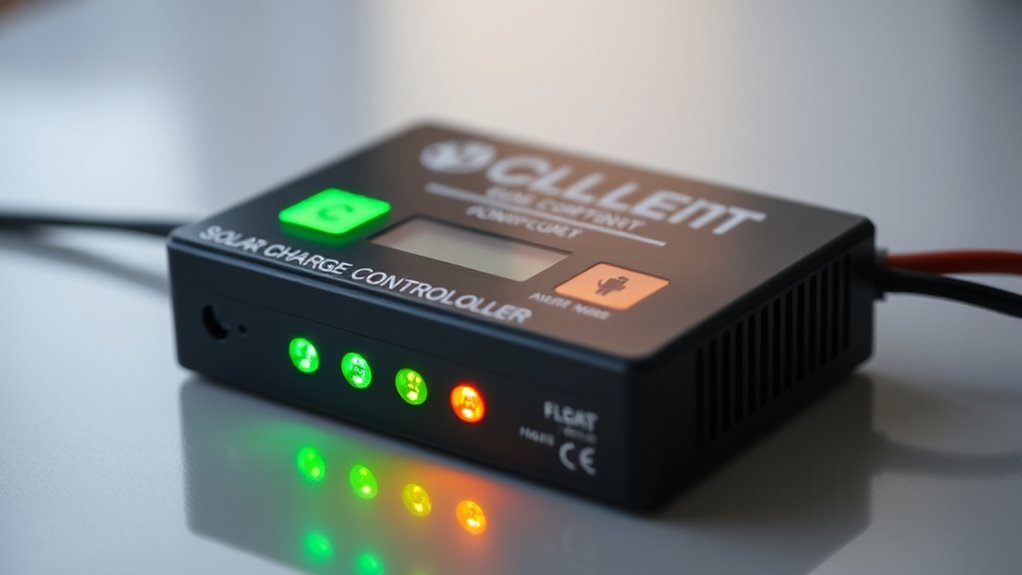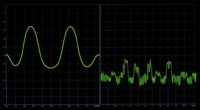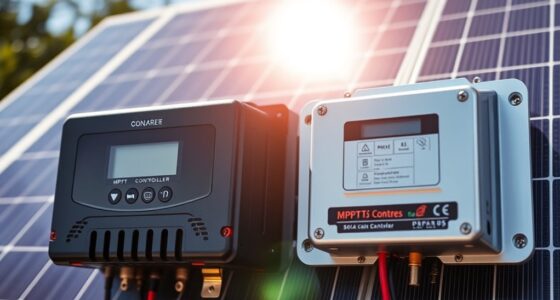Understanding the three main solar charge stages—bulk, absorption, and float—is key to optimizing your system. During bulk, your batteries receive maximum current to quickly restore capacity. In absorption, the voltage stabilizes to fully saturate the batteries and prevent damage. Finally, float maintains a low charge to keep batteries ready without overcharging. Properly managing these stages guarantees your batteries stay healthy and perform well longer. Keep exploring to learn how each stage works in detail.
Key Takeaways
- Bulk stage rapidly charges the battery by applying maximum current until reaching a set voltage limit.
- Absorption stage maintains a constant voltage, allowing electrolyte saturation and preventing overcharging.
- Float stage supplies a low, steady voltage to keep the battery fully charged during inactivity.
- Transitioning between stages involves adjusting voltage regulation to prevent damage and optimize performance.
- Proper staging ensures battery health, prolongs lifespan, and maximizes solar energy efficiency.
Understanding the Bulk Charging Phase

The bulk charging phase is the initial stage where your solar system rapidly replenishes the battery’s capacity. During this phase, your solar panel efficiency plays a crucial role, as it determines how quickly energy flows into the battery. As your panels generate power, the battery charges at its maximum rate, making efficient solar panels essential to optimize this process. Proper battery capacity management guarantees you don’t overcharge or undercharge, prolonging battery life and maintaining system performance. You’ll notice the voltage rising steadily as the battery approaches full capacity. This stage is vital because it sets the foundation for the subsequent absorption and float phases. Additionally, understanding the Gold IRA options can help diversify your investment portfolio for long-term financial stability. Maintaining battery health through proper management can prevent issues like capacity loss or reduced efficiency over time. Ensuring your system includes appropriate charge controllers helps regulate voltage and current, further protecting your batteries. Proper monitoring of solar panel performance can help optimize energy collection during this phase and improve overall system efficiency. By managing these factors carefully, you ensure your solar system operates smoothly and efficiently, maximizing your energy harvest. Monitoring system performance helps identify optimal charging times and maintain battery health throughout this process.
The Role of Absorption in Battery Charging

As the battery approaches full charge after the bulk phase, absorption begins to slow the rapid influx of energy to prevent overcharging. During this stage, the charger maintains a steady charge voltage close to the battery’s ideal level, tailored to its specific chemistry. This controlled process allows the battery to absorb remaining energy efficiently without risking damage. The absorption phase ensures the electrolyte reaches full saturation, balancing the chemical reactions within the cells. Your charger carefully regulates the charge voltage, matching the battery’s needs as it nears full capacity. This gradual tapering minimizes stress on the battery, extends its lifespan, and ensures it’s fully charged without overloading. Understanding this stage helps maximize battery performance and longevity in your solar power system, especially in charge cycle management. Proper regulation during this stage also helps prevent overheating, which can reduce battery efficiency and safety. Recognizing the importance of battery chemistry helps optimize the entire charging process for better durability. Additionally, monitoring charge voltage during absorption can provide insights into the health and efficiency of your battery system. Furthermore, implementing temperature compensation can enhance the safety and effectiveness of the charging process.
How the Float Stage Maintains Battery Health

Once the battery reaches its full charge during the absorption stage, it enters the float stage to maintain its health and readiness. During this stage, the charger supplies a low, steady voltage that prevents the battery from discharging while avoiding overcharging. This gentle maintenance helps extend your battery’s lifespan by reducing stress and preventing damage. Proper float charging also supports electrolyte maintenance, keeping the liquid levels balanced and ensuring ideal chemical reactions. By stabilizing voltage and current, the float stage minimizes corrosion and sulfation, which can degrade your battery over time. This careful balancing act preserves the battery’s capacity and prolongs its effective life, so your system remains reliable and efficient for years to come. Additionally, battery chemistry plays a crucial role in how well the float stage maintains overall health and performance. Understanding charge control is essential for optimizing your battery’s longevity and efficiency. Regular monitoring of voltage regulation can further prevent potential issues during the float stage, ensuring optimal battery performance over its lifespan. Proper float stage management is especially important for lead-acid batteries, which are sensitive to overcharging and require precise voltage control. Incorporating temperature compensation can further enhance the effectiveness of float charging by adjusting voltage levels based on ambient conditions.
Transitioning Between Charge Stages

Switching between charge stages is a critical process that guarantees your battery reaches its full capacity safely and efficiently. During a charge cycle, the charger adjusts voltage regulation to shift from bulk to absorption and eventually to float. As the battery approaches full capacity, the voltage gradually decreases, signaling the changeover to the absorption stage. This controlled change prevents overcharging and extends battery life. When the battery nears full charge, the system further reduces voltage to enter the float stage, maintaining optimal health. Proper progression between stages ensures your battery receives the right amount of energy at each phase, avoiding damage and maximizing lifespan. Monitoring voltage regulation during these shifts is essential for a smooth, safe, and effective charge cycle. Additionally, understanding the charge stages helps optimize battery performance and longevity. Recognizing these transition points can also aid in diagnosing potential charging issues early on. A thorough understanding of tuning processes used in various vehicles can further help in maintaining optimal battery and engine performance. Being aware of voltage regulation techniques can also improve your ability to troubleshoot charging problems effectively. Familiarity with battery chemistry can provide deeper insight into how different batteries respond to charging cycles.
Optimizing Solar Battery Performance Through Proper Staging

Proper staging during a solar battery charge cycle is essential for maximizing performance and extending battery life. When you follow the correct stages—bulk, absorption, and float—you ensure the battery receives the right amount of charge at each phase. This careful management helps prevent overcharging and deep discharges, which can degrade battery health over time. By managing these stages precisely, you can improve overall system reliability and guarantee your battery lasts longer. Additionally, proper staging reduces unnecessary energy loss, making your solar setup more efficient. Ensuring the use of well-drained soil and full sun exposure can further optimize solar panel performance and battery charging efficiency. Ultimately, paying attention to staging helps you get the most out of your solar investment while safeguarding your battery’s longevity.
Frequently Asked Questions
How Do Temperature Changes Affect Each Charging Stage?
Temperature fluctuations can impact each charging stage’s efficiency. When it gets colder, batteries may charge slower during the bulk stage, reducing efficiency. Conversely, higher temperatures can cause overcharging risks during absorption and float stages, potentially damaging the battery. You should monitor temperature changes closely, as they influence how well each stage performs. Adjusting your system or using temperature compensation helps maintain ideal charge cycles and prolongs your battery’s lifespan.
Can Improper Staging Damage Solar Batteries Over Time?
Improper staging is like neglecting a plant; it can gradually harm your solar batteries. If you don’t manage the charge properly, you risk reducing battery lifespan and lowering charge efficiency over time. Inconsistent or incorrect stages may cause overcharging or undercharging, which stresses the cells. This damage accumulates slowly, leading to decreased performance and earlier replacements, so ensuring proper charge staging helps protect your investment and keeps your system running smoothly.
What Are Signs of Incorrect Charge Stage Transitions?
If you notice your batteries aren’t reaching proper voltage regulation during the charge cycle, it’s a sign of incorrect charge stage shifts. You might see overcharging or undercharging, leading to inconsistent voltage levels. This disrupts the normal charge cycle, causing potential damage. Keep an eye on voltage levels at each stage, and make certain your system shifts smoothly between bulk, absorption, and float to protect your batteries.
How Do Different Battery Chemistries Impact Staging?
Think of battery chemistry as different musical instruments with unique tuning needs. Your battery chemistry influences how each stage plays out, affecting charging efficiency. For example, lithium-ion batteries charge faster and tolerate higher voltages, while lead-acid batteries require gentler shifts. Understanding these differences guarantees your system adapts correctly, optimizing charge stages. Tailoring your charging approach to your battery chemistry prevents missteps and maximizes performance, much like an expert conductor guiding a symphony.
Is Manual Adjustment of Charge Stages Ever Advisable?
You can consider manual adjustment of charge stages if you’re experienced and aiming for charge optimization. It’s advisable only when you understand your battery chemistry and how different stages impact performance. Incorrect manual adjustments can damage your batteries or reduce their lifespan. Always consult your manufacturer’s guidelines or a professional before making manual changes, as proper staging guarantees efficiency and long-term health of your solar system.
Conclusion
As you navigate the solar charge stages, imagine each phase as a gentle tide guiding your batteries to full strength. From the steady rush of bulk to the calming embrace of float, you control the flow, ensuring lasting power. By understanding and optimizing these stages, you keep your system humming like a well-tuned engine under a clear, sunlit sky. With this knowledge, your solar energy journey becomes a seamless dance of efficiency and durability.









